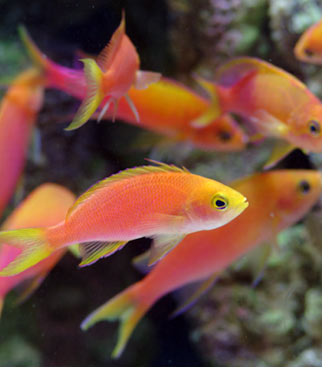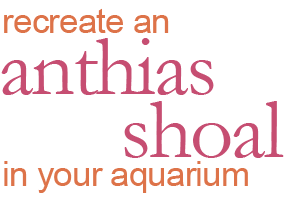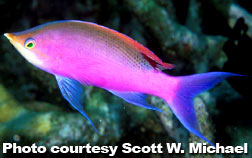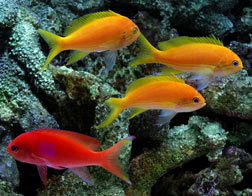Keeping the Jewels of the Reef:
The Anthias of the Genus Pseudanthias - Part 2
By Scott W. Michael
Now those of you that peruse the aquarium literature, or have had the good fortune to visit some public or private aquariums in Europe, have probably seen beautiful aquariums that were home to swarms of anthias! How do they do it? There are several keys to success when it comes to keeping a group of anthias. They are: species selection, shoal composition, the size of the tank, the size of the anthias group, and feeding.
If you are going to attempt to keep an anthias shoal, your chances of success will increase if the composition of the group consists principally of juvenile and female individuals. You should add only one male to the aquarium, unless the tank is large enough to accommodate more. Even then, the ratio should be highly skewed toward juveniles and/or females (a good rule of thumb would be one male to every four to six females/juveniles). Fortunately, the majority of anthias species are sexual dichromatic (that is, males and females differ in color). The size of the aquarium can also greatly impact your success in keeping anthias shoals. The general rule is that the larger the tank, the greater your chances of success in keeping a group of anthias. In a large tank, more submissive members of a shoal may be able to avoid more dominant conspecifics. In a smaller tank, it will be hard for weaker fish to avoid bullies. If you ever see photos of the European tanks, those tanks that are loaded with anthias are usually huge (in some cases, thousands of gallons).
Feeding can also reduce the likelihood of aggressive interactions between shoal members. If food is limited, fish tend to be more antagonistic toward conspecifics. While this is especially true for territorial reef fishes, a scarcity of nutrients can also lead to more quarreling in gregarious species like anthias and chromis. Feed your anthias at least three times a day (it is even better if you can feed them less, more often - for more on feeding see Part 3). I should point out, that some anthias will do fine if kept on their own. In fact, the more aggressive species will cause fewer headaches if only a single individual is housed per tank (this is especially true if your tank is smaller, say 55 gallons or less). One drawback in keeping some male anthias (e.g., Lyretail Anthias), in an aquarium without conspecifics is that their color may change and become more like that of the female.
 Scott Michael
Scott MichaelScott W. Michael is an internationally-recognized writer, underwater photographer, and marine biology researcher specializing in reef fishes, and was the Banquet Speaker at our 2007 and 2008 Coral Conference and Frag Swap. He is a regular contributor to Aquarium Fish Magazine, Freshwater and Marine Aquarium Magazine, SeaScope, and is the author of Reef Fishes Vol 1, Vol 2, and Vol 3, Vol 4, and Vol 5., A Pocket Expert Guide Marine Fishes, A Pocket Expert Guide to Reef Aquarium Fishes, 101 Best Saltwater Fishes: How to Choose and Keep Hardy, Brilliant, Fascinating Species That Will Thrive in Your Home Aquarium, Reef Sharks & Rays of the World, and Aquarium Sharks & Rays. Having studied marine biology at the University of Nebraska, Scott has served as a scientific consultant for National Geographic Explorer, the Discovery Channel, and French educational television. |
||||||||||||
|
|





 The anthias species vary in their aggressiveness. Those species that are less pugnacious are easier to keep in shoals. The
The anthias species vary in their aggressiveness. Those species that are less pugnacious are easier to keep in shoals. The


